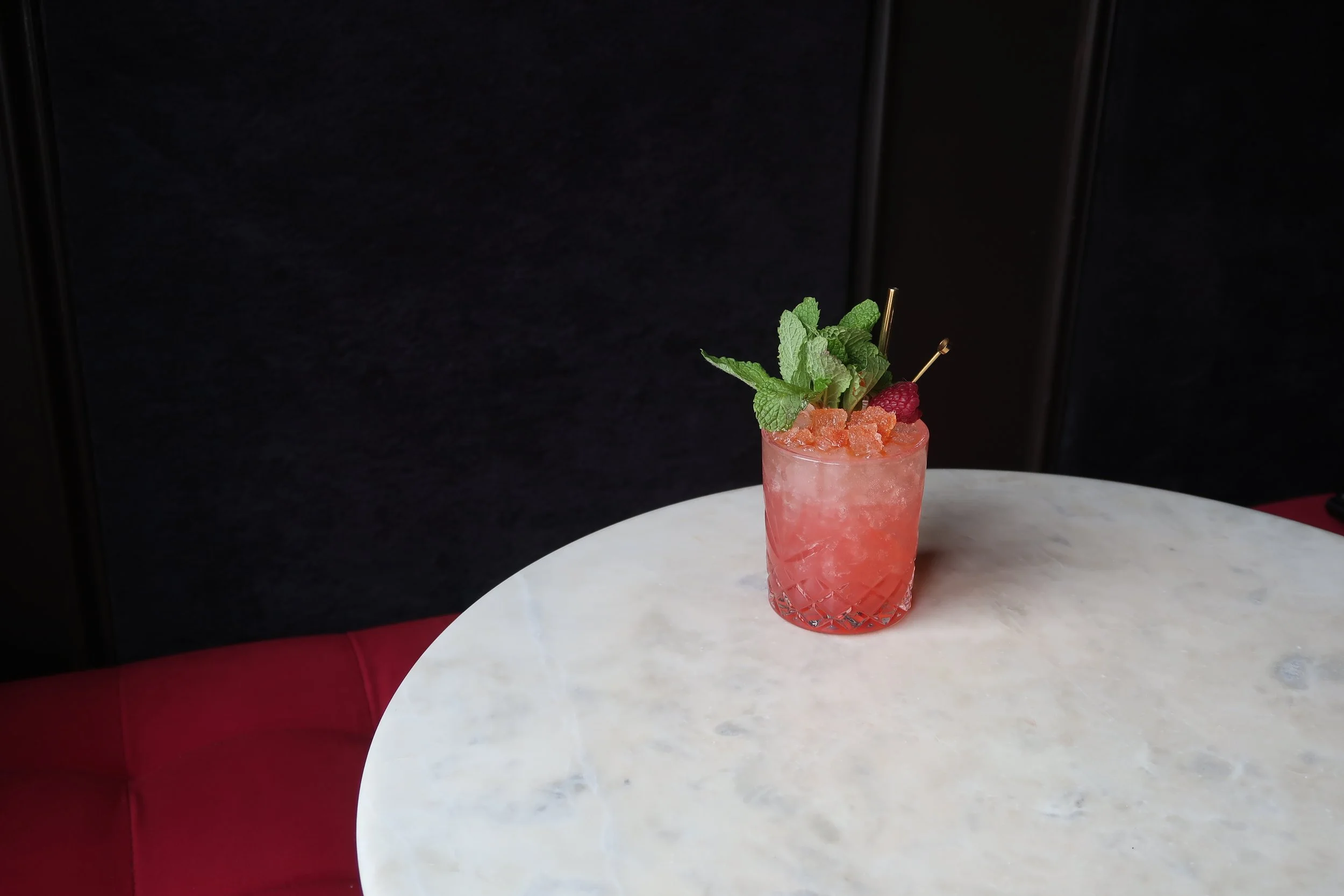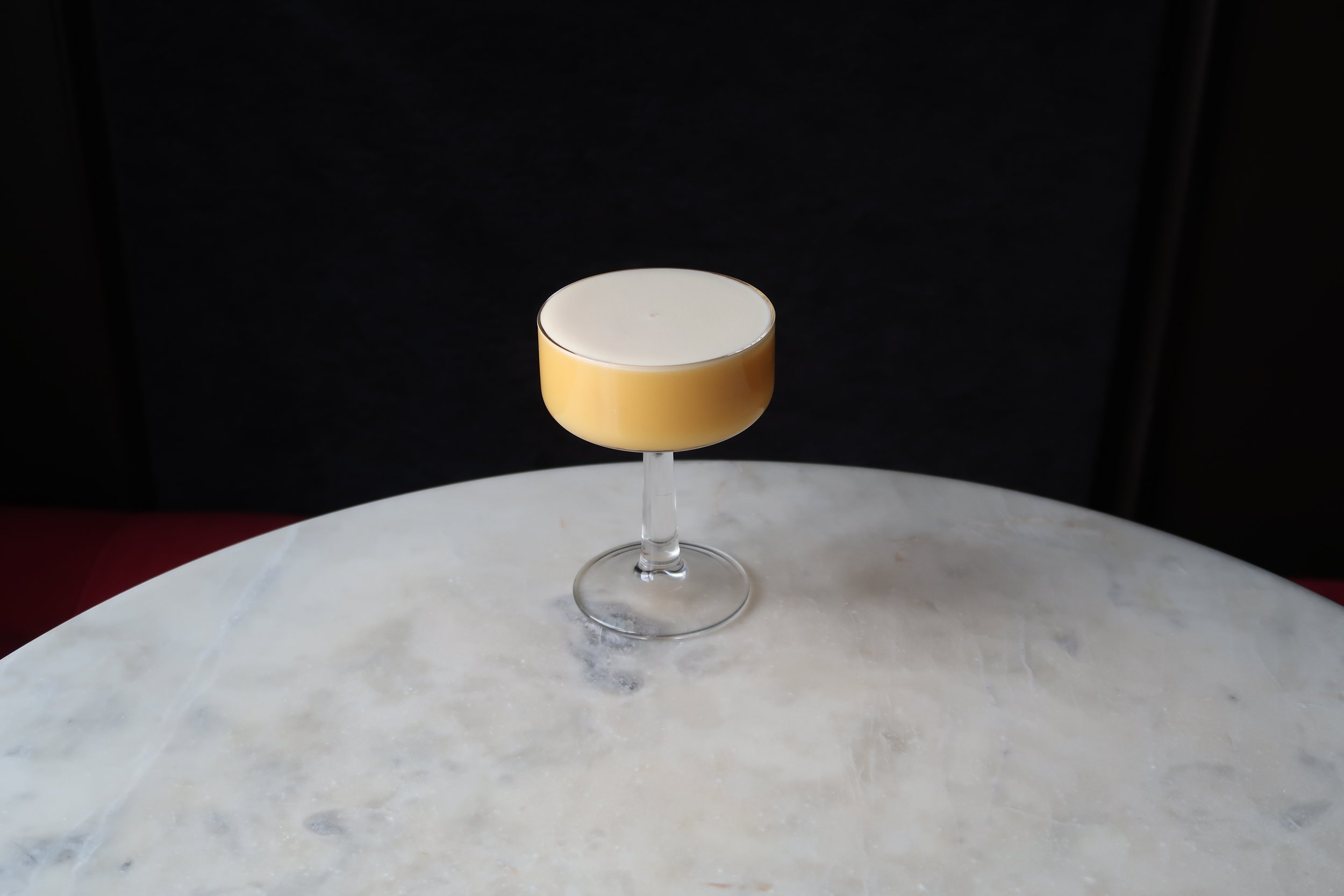Auditorium Cooler
This refreshing mocktail is a kind of Improved Ginger Ale, accented with lemon, raspberry, and Angostura bitters. The name makes me think about the moment in time when the first three Jack’s Manual editions were published (1908, 1910, 1916), the rise of the temperance movement, and teetotalers seeking entertainment at musical and theatrical performances given in auditoriums.
Grandpa’s Milk Shake
Simply listed as “Milk Shake” in Jack’s Manual, the original version of this drink is just raspberry syrup and milk, shaken with ice. I wanted to make a chocolatey version with more going on, so I made a kind of chocolate-raspberry milk base and added a scoop of chocolate ice cream on top with walnuts, reflecting the rise of the ice cream parlor and its relationship with the temperance movement.
Elk’s Delight
There are a few drinks with the word Elk in the name–Ccoktails, Fizzes, and egg-white Sours. It could be related to the majestic animal, of course, but more likely it’s related to the Benevolent and Protective Order of Elks, founded soon after the Civil War. This one is a grape juice-based drink with layers of citrus and spice, plus, in our version, true-to-period pineapple syrup.
Egg Phosphate
Acid phosphate was a staple of soda fountains–an acidic solution made with salts of calcium, magnesium, and potassium. Not so easy to come by these days, so I built this recipe with citric acid. Otherwise, it’s pretty close to the recipe in Jack’s Manual, with the additions of vanilla extract and orange oil (it’s shaken with a peel), which bring it even further into Orange Julius territory.
Gin Daisy
The second iteration of the cocktail template known as “Daisy,” this turn-of-the-century version uses grenadine as the primary sweetener and features a variety of spirits as the base, with the most popular choice being gin. I like the idea of making this super citrusy, hence the inclusion of Curaçao, which is a nod to the Daisy 1.0, and three different juices.
Ward Eight
One of the only cocktails to be most closely associated with Boston, the Ward Eight is a Whiskey Daisy with orange juice. For our version, I decided to include sherry as part of the base (it appeared in a 1930s Mr. Boston recipe for the drink), use acid-adjusted orange juice, and offer both a long, Daisy version, and a Sour style presentation, as well.
Jack Rose & the Pan American Clipper
The Jack Rose is a turn-of-the-century cocktail that has that golden age vibe–cool name, cool vibe. And the Pan Am Clipper (basically a Jack Rose with absinthe), a Charles H. Baker, Jr. drink, has the same caché, just a few decades later. There’s a lot of ways to make these cocktails well, but for this version, I cut back the grenadine and added rich simple for improved texture, plus a sneaky small measure of Jamaican rum to add dimension.
Pink Lady
The Pink Lady is a drink originating in the 1910s that features a split base of dry gin and apple brandy. Most specs include egg white and some include cream. I based our version on Harry McElhone’s recipe from his ABC of Mixing Cocktails, published in London in 1922, which does include both egg white and cream. Gorgeous color, delicious, and looks so good with a bitters design on top.
Old Tom Collins
The 1870s heralded the arrival of the Tom Collins in the world of American mixology, which itself had entered a new phase, one of codification through cocktail manuals. Though the Collins is commonly thought of as being served over generous amounts of ice, in this period (1875-1919), it’s often served like a Fizz (sans ice)–another drink that made a splash at this time. There’s also a fair amount of lime during this period, whether it’s split with lemon or on its own.
Mary Lennox
Named for the main character in The Secret Garden, this iced beauty combines the aesthetics of the Fix and the Bramble in a charming presentation. The malty genever base provides a canvas for the classic English flavors of rhubarb, ginger, and blackberry.
Holland House Sour
This delicious little number takes inspiration from several classics, including a variety of brandy sours and punches and, of course, the New-York Sour. A base of brandy, lemon, cacao, and vanilla gets topped off with a classic "claret snap" for a tannic note that fits really well with the dried fruit and chocolate in the drink.
Last Word
This classic cocktail entered the cocktail renaissance canon via Ted Saucier’s 1951 book Bottoms Up, where the recipe is credited to the Detroit Athletic Club and an Irish-born vaudeville star called Frank Fogarty. It likely came into being around 1915. The drink’s equal-parts construction balances out the strong flavors of juniper-heavy London dry gin, herbaceous green Chartreuse, and rich maraschino.
Aviation
This drink is both a relic of its original period (the years just before Prohibition) as well as of the cocktail revival of the aughts. It became an emblem of a certain kind of “golden-age” cocktail and people are still intrigued by its name and esoteric ingredients. It’s a little bit too floral for my palate these days, but it’s a great drink to have up your sleeve for friends who enjoy flowery gin drinks.
Corpse Reviver No. 2
With a name like this, it’s no wonder this cocktail has survived into the modern age; originally “corpse reviver” was a catch-all term for a hangover cure, but none has been more famous than this version. The other reason it’s survived is that it appears in the Savoy Cocktail Book (1930), one of the most popular cocktail guides of the twentieth century. Its equal-parts structure, bright ingredients, and absinthe rinse make this a perennially delightful sour.
Absinthe Frappé
The original Absinthe Frappé emerged in the later nineteenth century and was one of the first drinks to put absinthe in a starring role. Taking the traditional concept of chilling and diluting absinthe to bring out its flavors and make it palatable, this elegant cocktail is shaken with ice and served over crushed ice. Though anisette is the traditional liqueur in the spec, I found the combination of crème de menthe and fresh mint to be ideal here.
Sidecar du Roi
A sour that was popular at the Ritz Bar in Paris in the 1920s, the Sidecar traveled across the Atlantic and became a favorite drink in the U.S. during Prohibition. I took the spec developed by Ned King (get it? roi!) at Gigantic, which uses honey syrup in addition to orange liqueur; I decided to embrace the traditional sugar rim garnish, giving it dimension by adding chamomile.
Normande 75
The French 75 is traditionally made with Cognac or gin, lemon, sugar, and Champagne. I favor the Cognac version–which lives on as a New Orleans classic. I thought it would be fun to make a version inspired by Normandy, using Calvados in place of Cognac and, mirroring the grapes-on-grapes dynamic of the original, to pair the French apple brandy with dry cider in place of Champagne.
Jacqueminot Rose
The Jack Rose wasn’t invented in Paris, but it made a name for itself in the French capital’s expat scene. Though several versions exist, at times including orange juice, liqueurs, or vermouth, the version from Hugo Ensslin’s 1917 Recipes for Mixed Drinks is elemental and delicious. Our version calls on two French brandies–the Calvados as a nod to the American apple brandy of the original, and Cognac–along with a little absinthe for dimension.
Dizzy Does New York
This honeyed apple brandy Sour is a combination of a Dizzy Sour and a New York Sour. The New York Sour, as you likely know, is a rye whiskey Sour with a dry red wine float on top. The Dizzy Sour is far more obscure; it debuted in The Hoffman House Bartender’s Guide and consists of rye, Bénédictine, sugar, and lemon, with a rum float, when combined with the New York Sour, subbing in apple brandy and adding a touch of fig syrup, the result is a honeyed, tannic drink with citrus and dried fruit notes.
Bitter Widow’s Kiss
The Widow’s Kiss was first published in 1895’s Modern American Drinks by George Kappeler. The original recipe calls for apple brandy with equal measures of Bénédictine and yellow Chartreuse, plus Angostura bitters. Our take is dry and spirit-forward and switches out the Chartreuse in favor of Alpine amaro, which nods to the Alpine origins of Chartreuse and also does the work of the bitters. It’s got a Rusty Nail vibe that I really love.




















